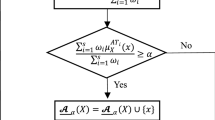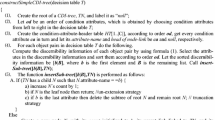Abstract
Most previous studies on rough sets focused on attribute reduction and decision rule mining on a single concept level. Data with attribute value taxonomies (AVTs) are, however, commonly seen in real-world applications. In this paper, we extend Pawlak’s rough set model, and propose a novel multi-level rough set model (MLRS) based on AVTs and a full-subtree generalization scheme. Paralleling with Pawlak’s rough set model, some conclusions related to the MLRS are given. Meanwhile, a novel concept of cut reduction based on MLRS is presented. A cut reduction can induce the most abstract multi-level decision table with the same classification ability on the raw decision table, and no other multi-level decision table exists that is more abstract. Furthermore, the relationships between attribute reduction in Pawlak’s rough set model and cut reduction in MLRS are discussed. We also prove that the problem of cut reduction generation is NP-hard, and develop a heuristic algorithm named CRTDR for computing the cut reduction. Finally, an approach named RMTDR for mining multi-level decision rule is provided. It can mine decision rules from different concept levels. Example analysis and comparative experiments show that the proposed methods are efficient and effective in handling the problems where data is associated with AVTs.










Similar content being viewed by others
References
Chen H, Li TR, Ruan D (2012) Maintenance of approximations in incomplete ordered decision systems while attribute values coarsening or refining. Knowl-Based Syst 31:140–161
Chen YL, Wu YY, Chang RI (2007) From data to global generalized knowledge. Decis Support Syst 52(2):295–307
Czarnowski I (2012) Cluster-based instance selection for machine classification. Knowl Inf Syst 30(1):113–133
DesJardins M, Rathod P, Getoor L (2008) Learning structured Bayesian networks: combining abstraction hierarchies and tree-structured conditional probability. Comput Intell 24(1):1–22
Dioşan L, Rogozan A, Pecuchet JP (2012) Improving classification performance of support vector machine by genetically optimising kernel shape and hyper-parameters. Appl Intell 36:280–294
Feng L, Li TR, Ruan D, Gou S (2011) A vague-rough set approach for uncertain knowledge acquisition. Knowl-Based Syst 24(6):837–843
Feng Q, Miao D, Cheng Y (2010) Hierarchical decision rules mining. Expert Syst Appl 37(3):2081–2091
Foithong S, Pinngern O, Attachoo B (2012) Feature subset selection wrapper based on mutual information and rough sets. Expert Syst Appl 39(1):574–584
Guan JW, Bell DA (1998) Rough computational methods for information systems. Artif Intell 105(1/2):77–103
Guan YY, Wang HK, Wang Y, Yang F (2009) Attribute reduction and optimal decision rules acquisition for continuous valued information systems. Inf Sci 179(17):2974–2984
Han J, Fu Y (1995) Discovery of multiple-level association rules from large databases. In: Proceedings of the international conference on very large data bases, pp 420–431
Han Y, Lam W (2007) Utilizing hierarchical feature domain values for prediction. Data Knowl Eng 61(3):540–553
Hassan YF (2011) Rough sets for adapting wavelet neural networks as a new classifier system. Appl Intell 35(2):260–268
Hong TP, Lin CE, Lin JH, Wang SL (2008) Learning cross-level certain and possible rules by rough sets. Expert Syst Appl 34(3):1698–1706
Hong TP, Liou YL, Wang SL (2009) Fuzzy rough sets with hierarchical quantitative attribute. Expert Syst Appl 36(3):6790–6799
Hu XH, Cercone N (2001) Discovering maximal generalized decision rules through horizontal and vertical data reduction. Comput Intell 17(4):685–702
Jo H, Na Y, Oh B, Yang J, Honavar V (2011) Attribute value taxonomy generation through matrix based adaptive genetic algorithm. In: Proceedings of the 20th IEEE international conference on tools with artificial intelligence, vol 1, pp 393–400
Kang DK, Kim MJ (2011) Propositionalized attribute taxonomies from data for data-driven construction of concise classifiers. Expert Syst Appl 38(10):12739–12746
Kang DK, Silvescu A, Zhang J, Honavar V (2004) Generation of attribute value taxonomies from data for data-driven construction of accurate and compact classifiers. In: Proceedings of the 4th international conference on data mining, pp 130–137
Kang DK, Sohn K (2009) Learning decision trees with taxonomy of propositionalized attributes. Pattern Recognit 42(1):84–92
Li T, Ruan D, Geert W, Song J, Xu Y (2007) A rough sets based characteristic relation approach for dynamic attribute generalization in data mining. Knowl-Based Syst 20(5):485–494
Liu C, Miao D, Zhang N (2012) Graded rough set model based on two universes and its properties. Knowl-Based Syst 33:65–72
Parthalain N, Shen Q, Jensen R (2010) A distance measure approach to exploring the rough set boundary region for attribute reduction. IEEE Trans Knowl Data Eng 22(3):305–317
Pawlak Z (1982) Rough sets. Int J Comput Inf Sci 11(5):341–356
Pawlak Z, Skowron A (2007) Rough sets: some extensions. Inf Sci 177(1):28–40
Qian YH, Liang JY, Dang CY (2008) Converse approximation and rule extraction from decision tables in rough set theory. Comput Math Appl 55(8):1754–1765
Qian YH, Liang JY, Pedrycz W, Dang CY (2010) Positive approximation: an accelerator for attribute reduction in rough set theory. Artif Intell 174(9/10):597–618
Qian YH, Liang JY, Pedrycz W, Dang CY (2011) An efficient accelerator for attribute reduction from incomplete data in rough set framework. Pattern Recognit 44(8):1658–1670
Ramentol E, Caballero Y, Bello R, Herrera F (2012) SMOTE-RSB∗: a hybrid preprocessing approach based on oversampling and undersampling for high imbalanced data-sets using SMOTE and rough sets theory. Knowl Inf Syst 33(2):245–265
Riquelme JC, Aguilar JS, Toro M (2000) Discovering hierarchical decision rules with evolutive algorithms in supervised learning. Int J Comput Syst Signals 1(1):73–84
Rzepakowski P, Jaroszewicz S (2012) Decision trees for uplift modeling with single and multiple treatments. Knowl Inf Syst 32(2):303–327
Sadoghi Yazdi H, Rowhanimanesh A, Modares H (2012) A general insight into the effect of neuron structure on classification [J]. Knowl Inf Syst 30(1):135–154
Salamó M, López-Sánchez M (2011) Rough set based approaches to feature selection for case-based reasoning classifiers. Pattern Recognit Lett 32(2):280–292
Srikant R, Agrawal R (1997) Mining generalized association rules. Future Gener Comput Syst 13(2):161–180
Tsumoto S (2003) Automated extraction of hierarchical decision rules from clinical databases using rough set model. Expert Syst Appl 24(2):189–197
Verma B, Hassan SZ (2011) Hybrid ensemble approach for classification. Appl Intell 34(2):258–278
Vinh LT, Lee S, Park YT, d’Auriol BJ (2012) A novel feature selection method based on normalized mutual information. Appl Intell 37(1):100–120
Wang L, Yang B, Chen Y et al (2012) Improvement of neural network classifier using floating centroids. Knowl Inf Syst 31(3):433–454
Wang SKM, Ziarko W (1985) On optimal decision rules in decision tables. Bull Pol Acad Sci 33(11–12):693–696
Yao Y, Zhao Y (2008) Attribute reduction in decision-theoretic rough set models. Inf Sci 178(17):3356–3373
Ye MQ, Wu XD, Hu XG, Hu DH (2013) Anonymizing classification data using rough set theory. Knowl-Based Syst. doi:10.1016/j.knosys.2013.01.007
Zhang J, Kang DK, Silvescu A, Honavar V (2006) Learning accurate and concise naive Bayes classifiers from attribute value taxonomies and data. Knowl Inf Syst 9(2):157–179
Zhang X, Chen G, Wei Q (2011) Building a highly-compact and accurate associative classifier. Appl Intell 34(1):74–86
Ziarko W (2003) Acquisition of hierarchy-structured probabilistic decision tables and rules from data. Expert Syst 20(5):305–310
Acknowledgements
The authors would like to thank the anonymous referees for their valuable comments. This paper is in part supported by the National High Technology Research and Development Program (863 Program) of China under Grant 2012AA011005, the National 973 Program of China under Grant 2013CB329604, the National Natural Science Foundation of China (NSFC) under Grants 60975034, 61272540 and 61229301 and the US National Science Foundation (NSF) under Grant CCF-0905337.
Author information
Authors and Affiliations
Corresponding author
Rights and permissions
About this article
Cite this article
Ye, M., Wu, X., Hu, X. et al. Multi-level rough set reduction for decision rule mining. Appl Intell 39, 642–658 (2013). https://doi.org/10.1007/s10489-013-0439-3
Published:
Issue Date:
DOI: https://doi.org/10.1007/s10489-013-0439-3




